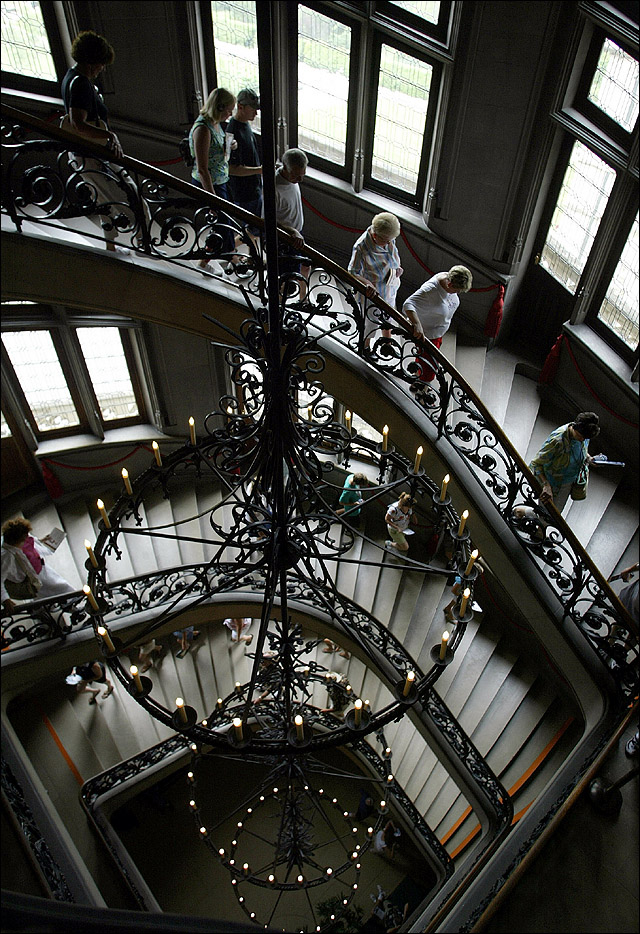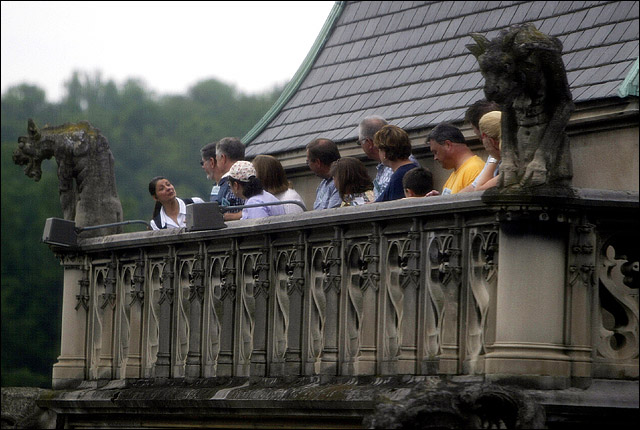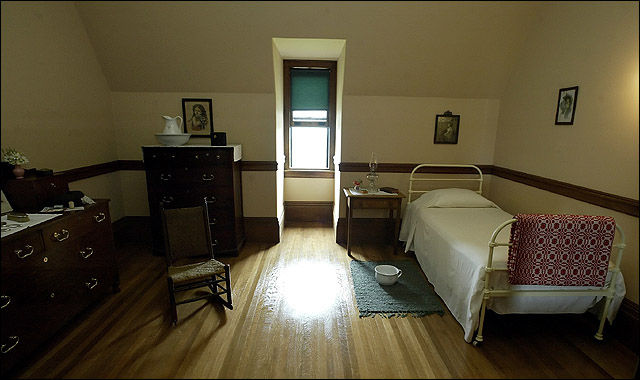Backstairs at the Biltmore House
America's largest home opens new doors to guests
ASHEVILLE, N.C. ? Seventy-five years after it was first opened to the public, George W. Vanderbilt’s grand Biltmore House – the largest home in the United States – is showing off a new side.
Ten rooms on the fourth floor – including several that housed the servants who kept the 250-room house running – have been restored and opened to the public for the first time.
Three bedrooms, a bathroom, a cedar-lined closet for ultra-fine linens and the hall where servants spent their scarce free time offer insight into the backstairs lives of the approximately 40 men and women who worked “in service” at Biltmore during its turn-of-the-20th century heyday.
“We knew by opening these 10 rooms, there were so many stories we could tell,” curator Darren Poupore said during a recent tour of the rooms that opened to the public July 1.

The Biltmore House is reflected in a pond on the estate in Asheville, N.C. Seventy-five years after it was first opened to the public, George W. Vanderbilt's grand Biltmore House is showing off a new side. Ten rooms on the house's fourth floor - including several that housed the servants who kept the 250-room house running - have been restored and opened to the public for the first time.
As illustrated by the recent film “Gosford Park” and the PBS reality series “Manor House,” the social interactions between masters and servants and among servants still have the power to fascinate, decades after such rigid class distinctions came to an end.
The newly opened rooms offer visitors a sense of life behind the scenes at Biltmore, which was completed in 1895 by George Washington Vanderbilt III, a grandson of Commodore Cornelius Vanderbilt, the railroad and shipping tycoon. A virtual castle, the home was designed by architect Richard Morris Hunt, modeled after the great chateaus of the Loire Valley.
Going behind the scenes
The house opened to public tours in 1930, but since the 1950s, the fourth-floor rooms had been used mainly to store furniture. Starting in 1989, some visitors began getting glimpses on special “Behind the Scenes” tours, but the rooms remained unrestored.

Visitors descend a grand staircase at the Biltmore House. Tours now offer a look backstairs at the opulent home.
Now, visitors taking the self-guided tour can climb from the third floor’s North Tower Room to walk down a wing of the servant’s quarters. Hanging in a closet are reproductions of the sort of uniforms worn by Biltmore’s housemaids – a gingham or calico dress by day, followed by a more formal black-and-white dress for nighttime.
The bathrooms, while plain, offered indoor plumbing – still a luxury in western North Carolina in the early 20th century.
“In a lot of ways, the standard of living for servants was a lot higher then they would have had somewhere else,” Poupore said.
Visitors also have a chance to peek into three bedrooms where maids once slept. Like the bathroom, they are relatively plain but comfortable, with the feel of dormitory rooms.
There were 21 bedrooms for female servants on the house’s fourth floor; male under-butlers and houseboys were quartered elsewhere to discourage fraternization between the sexes. With the exception of the head butler and the chef, who were allowed to live offsite, servants had to be unmarried.
Piecing together history
To help piece together the story behind the “new” rooms, Poupore and Ellen Rickman, Biltmore’s director of museum services, consulted estate records and “Millionaire Households,” a tell-all book penned in 1903 by a former servant in a Gilded Age mansion.
The book – written by “Mary Elizabeth Carter” under what is believed to be a pseudonym – details hierarchies among servants, the uniforms they wore, their working hours and the tasks they performed in mansions of the era.

Visitors to the Biltmore House can now look out from the roof outside George Vanderbilt's Observatory at the estate in Asheville, N.C.
“The woman presiding over (household work) should be wise as a serpent and harmless as a dove,” Carter writes in the opening sentences of the book. “Above all to a high sense of duty unswervingly loyal.”
Poupore and Rickman said Carter’s book made it clear that while male butlers headed grand British homes, in America it was a woman – the head housekeeper – who ran the show.
At Biltmore, Poupore said, the best-known head housekeeper was Mrs. Emily King, a widow who came to western North Carolina from England in 1897 and served until at least 1917. According to Rickman and Poupore, former servants interviewed years later for oral histories still referred to King as “The Matron.”
An 1898 ledger that Rickman and Poupore found during their research showed King was paid $300 a month, double the chief butler’s $150 salary.
In a servant’s hall, where the household staff gathered to read or sew during off hours, there are tables for ironing linens, and a call box and telephone used to summon servants to different areas of the vast house.

Servants' bedrooms were sparse but comfortable. The standard of living for servants at the Biltmore House was higher than what many Americans of the day enjoyed.
A servant’s day generally began by 6 a.m. and didn’t end until 9 p.m. Rickman said, with perhaps a couple hours of free time in the afternoon. Servants got one day off per week and half of every other Sunday.
New public rooms
Also newly restored are a pair of fourth-floor “public” rooms. One is the Model Room, featuring a giant cabinet built to display the 1889 architect’s model that Hunt presented to Vanderbilt prior to starting construction of Biltmore House. Visitors can climb short sets of stairs to get a closer look at the detailed model; also on display are some of Hunt’s original drawings for the house, while photographs show the French chateaus that inspired Hunt’s design.
Just off the Model Room is the Observatory, with gorgeous oak paneling, a fireplace, leather sofa and club chairs, and a narrow spiral staircase leading up to a walkway around the perimeter of the room.
From the walkway, Vanderbilt and his guests had access to balconies from which he could show off Biltmore House’s dramatic rooflines and gargoyles, the copper roofing imprinted with gilded GV monograms, and the Blue Ridge vistas in the distance.
George Vanderbilt spent much of his inheritance on Biltmore, and died at age 51. His siblings – also heirs to Commodore Vanderbilt’s fortune – built mansions elsewhere around the country, including The Breakers and Marble House in Newport, and an estate in Hyde Park, in New York’s Hudson Valley. The Biltmore Estate is still owned by the descendants of George Vanderbilt, who operate it as a combination historic home and destination resort.
If you go
Getting there: The entrance to Biltmore Estate is in Biltmore Village, just off Exit 50 on Interstate 40, south of Asheville, N.C.
Tickets: Day passes for self-guided tours of the house, gardens, winery, conservatory and other estate attractions are $39 for adults, $19.50 for children 6 to 16. Guided and behind-the-scenes tours are an extra $15. Tickets can be purchased at www.biltmore.com, by calling (800) 624-1575 or at the estate. The grounds are open 8:30 a.m. to 5 p.m. March 15 through Dec. 31, 9 a.m. to 4 p.m. from Jan. 1 to March 14.
Lodgings: The top-rated Inn on Biltmore Estate has rooms starting from around $200 a night, with packages available.
Things to do: Outdoor activities abound on the 8,000-acre estate, which was laid out by the landscape architect Frederick Law Olmstead, from biking and hiking trails to river float trips, fly-fishing trips and horseback riding.
The book: The Open Collections Program at Harvard University’s library has made the text of “Millionaire Households” available online at ocp.hul.harvard.edu/ww/allbooks.html.

